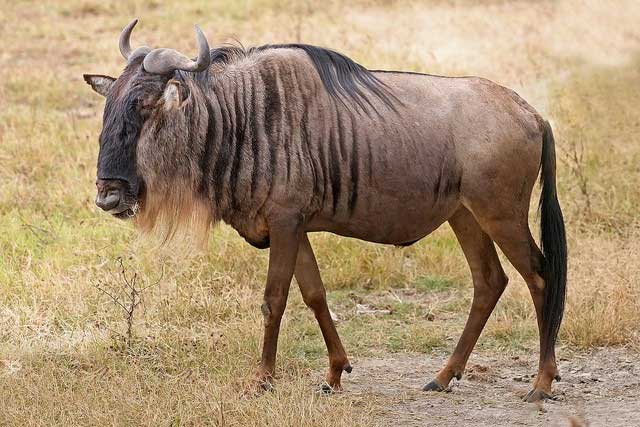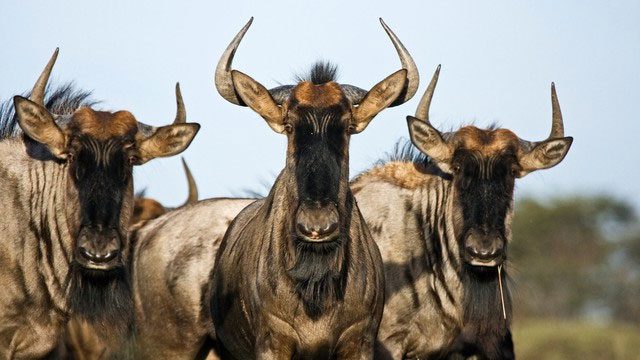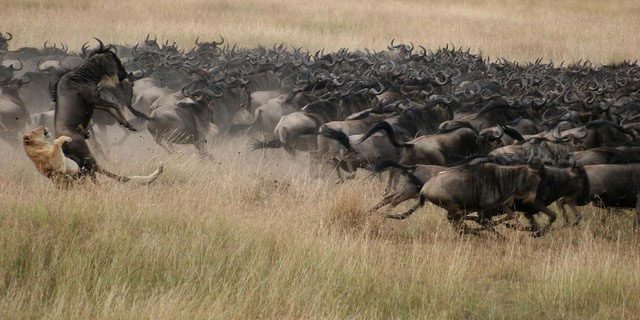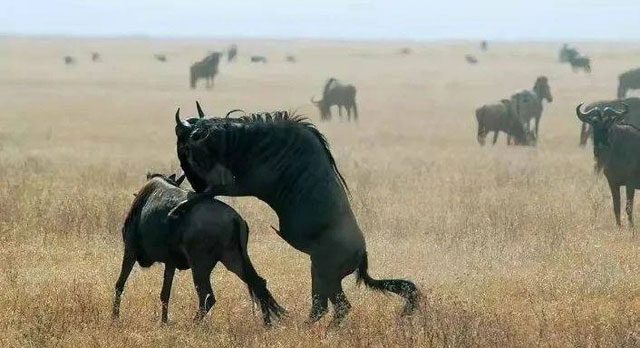In the vast African grasslands, there exists a remarkable group of creatures – the wildebeest. These animals combine characteristics of various species: they have a fierce temperament like wild horses, powerful strength akin to bison, and a peculiar appearance that blends a bit of gentleness, reminiscent of sheep.
The unique shape of the wildebeest, including its body, horns, and beard, is often hard to describe. Even more noteworthy is their significant role as a “mobile meat supply” on the African savannahs.
The wildebeest, belonging to the Bovidae family and Artiodactyla order, can be broadly classified into two types: the black wildebeest and the blue wildebeest. They are primarily concentrated in the vast grasslands of Africa. Wildebeests are remarkably strong, with an adult weighing up to 270 kg, making them a “heavyweight” contender on the savannah.

With their large, muscular appearance and characteristic curved horns, wildebeests (Syncerus caffer) are one of the iconic animal species of the African savannah. This species is widely distributed across grasslands, savannas, and open forests in East and Southern Africa, with an estimated population of around 1.8 million.
They have a slender body covered in brown fur, with a distinctive black mane on their neck, a feature that makes them unique on the savannah. Additionally, their beard and striped patterns on their bodies are key identifiers.
It is noteworthy that wildebeests have an extremely keen sense of smell, capable of detecting hard-to-find water sources. This extraordinary sensory ability gives them a unique advantage when searching for water and food.
Despite their mysterious presence, wildebeests are native residents of the African wilderness, naturally born from this land. However, it wasn’t until 1842 that scientists officially discovered this species, leading to its gradual recognition worldwide.

Wildebeests have a large, muscular body with a shoulder height ranging from 1.4 to 1.7 meters and average weight between 200 to 250 kg. They possess short brown fur with black stripes on their shoulders and hindquarters. Their name “wildebeest” comes from their large heads with backward-curving horns, which can grow nearly 1 meter long.
Wildebeests are herbivores, feeding on leaves and branches. Their lifespan is about 20 years, considered relatively long for wild animals in Africa. Due to their large size, wildebeests have relatively few natural predators on the African savannah. Coupled with their social behavior, this group living further enhances their sense of safety.
Speaking of living in herds, this seems to be a natural habit of wildebeests. Each year, they undertake large-scale migrations similar to migratory birds. This migratory behavior is often a survival strategy employed by herd-living species.
During migration, safety is of utmost importance, and the large size and group strength of wildebeests provide them with a certain level of protection. In non-migratory seasons, wildebeests typically live in small groups of about 30 individuals. However, as the dry season approaches, they gather into massive herds of hundreds of thousands, even millions, and embark on their migration journey together.

Wildebeests live in herds, with numbers ranging from dozens to thousands of individuals. The herd is typically led by a dominant male, responsible for protecting the group from threats and attracting females.
The onset of the dry season is a spectacular sight on the African grasslands. Millions of wildebeests migrate from Tanzania to Masai Mara, a journey of 3,000 km. This migration is a life-and-death challenge for the wildebeests. They must face not only food and water shortages but also the attacks of lions, leopards, and crocodiles. Nonetheless, they bravely embark on this perilous journey in search of a better habitat.
So why are wildebeests referred to as “the mobile meat supply of the savannah?” This is primarily due to their large numbers and strong reproductive capabilities. New generations of wildebeests are continuously increasing at a rapid pace, providing a stable energy source for the food chain on the grasslands.
The fixed annual migration period allows many predator species to rely on wildebeests for survival. Although wildebeests suffer heavy losses during this migration, their existence undoubtedly contributes significantly to the balance of the savannah ecosystem.

Wildebeests are excellent runners, capable of reaching speeds up to 80 km/h. They are also talented jumpers, able to leap over obstacles up to 2 meters high. This extraordinary mobility helps them escape from predators and search for food in vast terrains. Wildebeests play a crucial role in the African ecosystem. They are a food source for numerous predators, including lions, leopards, and wild dogs.
Additionally, wildebeests are highly active and primarily herbivorous, making their meat very tasty and a favored prey for many carnivores. The migration of wildebeests not only provides this species with a rich food source but also promotes the maintenance of biodiversity on the grasslands.
In conclusion, wildebeests have become an indispensable part of the African savannah with their unique survival strategies and significant roles in the savannah ecosystem. Their existence and migratory behavior not only enliven the grasslands but also create the foundation and ensure the survival of other species.

One of the most intriguing mysteries about wildebeests is their migratory behavior. Each year, millions of wildebeests travel thousands of kilometers from the Serengeti in Tanzania to Masai Mara in Kenya in search of food and water. This is one of the largest animal migrations in the world.
Wildebeests are beautiful and important wild animals that play a vital role in the African ecosystem. Protecting wildebeests and their habitats is essential for maintaining biodiversity and the balance of the ecosystem.


















































